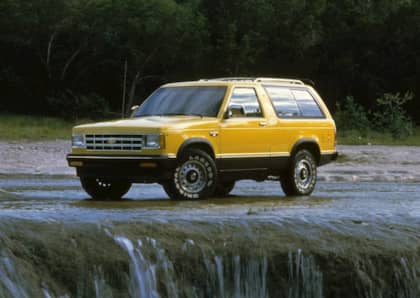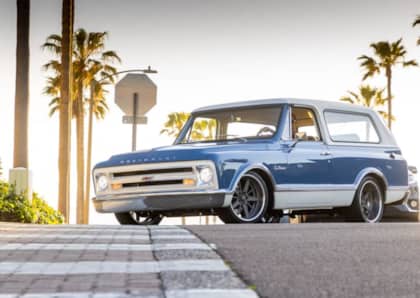The 1973-1991 Chevrolet K5 Blazer Was GM's Last Old School 4X4 SUV
When the Chevrolet K5 Blazer appeared in 1969, it sparked a revolution in SUV design. Conceived to battle the Ford Bronco, the Blazer one-upped its rival by adopting the larger platform of the C/K full-size pickup, giving Chevy an advantage in terms of payload, passenger room, and production costs.

In 1973 Chevrolet's trucks were redesigned, which meant that the second-generation Blazer got a new chassis and fresh styling to go with it. This 'squarebody' version of the sport-utility vehicle went on to define the next two decades of the brand's rugged, off-road friendly people mover, leading rivals Ford and Dodge into a pickup-based future for full-size SUVs. Along the way, the tough, yet mechanically simple K5 Blazer (and its GMC Jimmy sibling) carved out a reputation among owners and collectors alike as the last of the automaker's old school 4x4s.
Big Body
Although it was still riding on a short-wheelbase version of the C/K frame, the 1973 Chevrolet Blazer was substantially longer (7 inches overall, 2.5 inches of that in the wheelbase) and just a smidge (0.6 inches) wider than the model it replaced. Fender wells went from round to square, and the bulkier lines of the Blazer's new sheet metal gave the SUV a much heftier appearance.

From 1973 to 1975, Chevrolet maintained the full-convertible aspect of the Blazer's removable fiberglass roof, but after that the decision was made to carry over the pickup's steel cab and relegate the lift-off section to the vehicle's rear quarters. The second-gen Blazer also featured roll-down rear glass that disappeared into the tailgate, replacing the lift-up access that had been offered by the original SUV.

As an off-road package, the K5 Blazer relied on a succession of New Process transfer cases matched with a pair of solid axles suspended by leaf springs. A mix of Dana 44, 12-bolt, and 10-bolt axles were used by Chevrolet, with later models moving to the 10 bolt design in the early 1980s. Its modest wheelbase made it a decent trail rig, although it was larger than the Bronco and Jeep's contemporary CJ.

Under the hood, the Chevrolet Blazer featured a mix of straight-six and small block V8 engines, ranging in size from 250 cubic inches all the way up to 400 cubic inches. The most common choices for the Blazer were the 305 and the 350 small block V8s. The former was introduced in 1981 and offered up to 170 hp and 260 lb-ft of torque, while the 350 was available right from the beginning and produced as much as 210 hp and 300 lb-ft of torque. Engines with the highest output were those that benefited from throttle-body fuel injection towards the end of the 1980s. A naturally-aspirated Detroit Diesel V8 engine that produced 135 hp and 240 lb-ft of torque was also offered from 1982 to 1991.
Same Old Song
One of the most remarkable aspects of the second-generation Chevrolet K5 Blazer is that it underwent very few changes over its lengthy time on the market. In 1981 a styling refresh brought with it stacked quad headlights, and a full-bar grille appeared in 1989, with upgrades such as anti-lock brakes also in the cards. Other than that, the look and feel of the Blazer remained remarkably similar throughout its entire run.

Part of why the K5 was able to soldier on for so many years with only modest customer interest was because it cost General Motors very little to build alongside its popular full-size pickups. The Blazer became an outpost of profit, a vehicle that could still earn decent coin among those who appreciated its go-anywhere capabilities and versatile utility, and who were willing to tolerate its throwback amenities.

While the 1970s proved to be lucrative for the SUV, in the '80s buyers were less enthusiastic about the giant Blazer's thirst for gasoline, and rising fuel prices put a serious damper on sales. It was also not as comfortable nor as nimble as the crop of smaller sport-utilities that were beginning to appear on the market from both Detroit and Japan.

As the '90s appeared on the horizon, it was clear that the K5 Blazer's days were numbered. In 1987, the GMT400 platform arrived under the Chevrolet C/K pickup, and 1991 would be the final model year for the K5 before it, too, moved to the more modern setup. Upon doing so, the full-size Blazer name would last only a handful of years as a two-door model before it was replaced by the Tahoe.

Today, the 1973-1991 Chevrolet K5 Blazer continues to be undervalued among collectors, especially models hailing from the 1980s. Without the hype of a modern-day revival (as with the Ford Bronco), the Blazer has stayed under the radar. With its dead-simple small block drivetrains, easy-to-work-on interiors and chassis, and strong parts availability thanks to sharing many of its mechanical details with same-era Chevy pickups, a well cared for Blazer can be an affordable gateway into the world of old school 4x4 SUVs.











